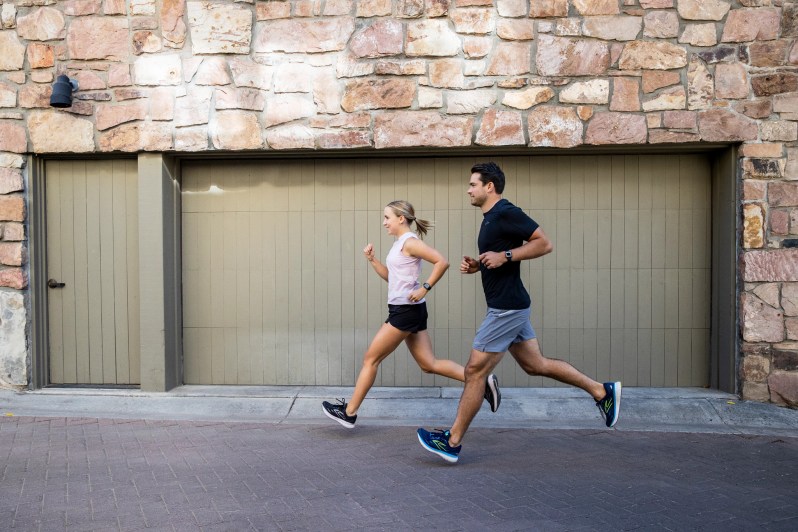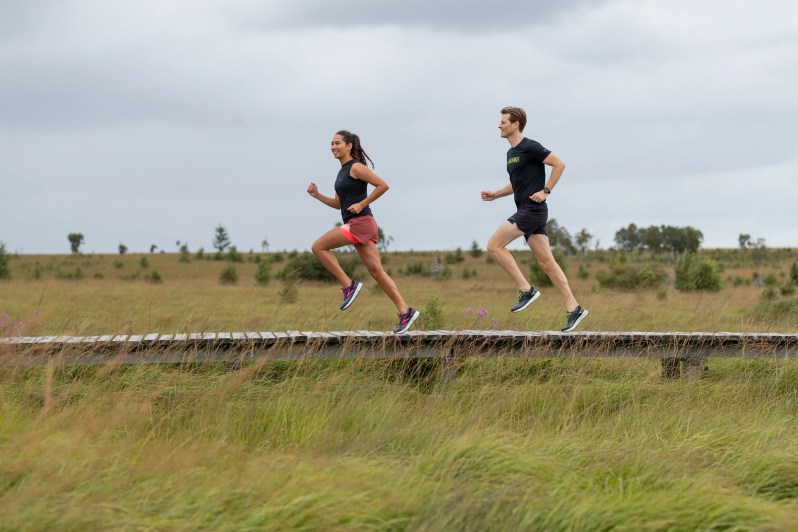
Maybe the most memorable experience you have with running was the dreaded mile from the President’s Physical Fitness Test in middle school. Maybe you’ve jogged the odd Firecracker 5K, Turkey Trot, or Jingle Bell Run but have long since lapsed. Or maybe you were a distance stud back in high school or college whose life got too busy to train, and now, out of shape but with some time on your hands, you’re ready to see how much gold is left in your legs.
Regardless of whether you’re just starting to get into running or you have countless experiences, there’s not another sport that blends efficiency, aerobic development, and, yes, even contemplation quite like distance running. For every kind of current non-runner looking to start or start again, it begins with the first step, and running coach Luke Humphrey has some advice.
Humphrey, 39, may seem like one of innumerable running coaches clotting the internet, but it’s not an exaggeration to say that in his prime, he and his teammates changed the course of American distance running forever. As part of the Hansons Brooks Distance Project, these former collegiate Division II, III, and NAIA runners, passed over by prestigious programs and cash-flush brands, were given a longshot to pursue Olympic dreams. Their base in suburban Detroit was far from the idyllic and more temperate training locales in California and Colorado. But mile by mile and year by year, the men packed on the miles (Humphrey himself put in 140 to 150 miles per week, and he wasn’t alone), and the-little-program-that-could has, over the past two decades, produced two Olympians and countless top-10 finishes in major marathons. Boasting a 2-hour, 14-minute, and 38-second best, as well as top-10 finishes in New York City, Chicago, and Boston, Humphrey knows his way around the roads, and the athletes he coaches subscribe to his philosophy: Mileage. “Volume,” he says, “is big.”
Of course, every person is different, and there’s no one-size-fits-all training program. You may still have some bad days even by consistently following Humphrey’s advice to the letter and step. “The trajectory in general will be positive, but you’re going to have ups and downs along the way,” he says. “It happens, and you have to keep plugging away.”
Related Guides
The Beginner-Beginner

You’ve always wanted to run, and today, this week, this year, it’s time. This is a good-news-bad-news situation. First, the good news: After a month, you’ll start to get into it, even enjoy it. But now for the bad news: It’s going to be a rough first month.
The most common mistake Humphrey sees beginning runners make stems from enthusiasm. You want to do everything all at once: Start running, clean up your diet, ditch the booze, drop pounds, aim for a solid eight hours of sleep, and more. “If you start with one thing,” Humphrey say, i.e. the running itself, “it leads into more healthy habits.”
Walk-running, where the runner takes brisk walk breaks at prescribed intervals between running, is great for building fitness. Start with as much as one minute runner and one minute walking, and as you grow more comfortable, increase the running times while keeping the walk breaks the same. Your goals is 30 minutes of running without a walk break, three or four times a week.
As far as increasing mileage, some say to add only 1% of the previous week’s total, but for many newcomers, that would mean a six-month buildup. It’s not practical. Add mileage as you feel comfortable.
Finally, quit browsing Amazon or running bloggers (including this one) for shoe options. Instead, head to your town’s running specialty store, which Humphrey calls the “town square for runners.” Not only will you be evaluated and fit for your specific needs, but these shops offer a wealth of information, as well as opportunities for socializing through group runs and even a future running buddy. You may pay a little more, but the long-term benefits are worth it.
In Summary
- It’s tough at first. It gets easier.
- Focusing on running consistently first before other lifestyle changes
- Walk-runs are king as you build to 30 continuous minutes
- Add mileage or time as you feel
- Buy good running shoes at a proper running shop
The Intermediate-Beginner

You’re the type who’s athletic and, for a spell, could shuffle through 5Ks and 10Ks while hungover, run a half marathon once a year, and even gutted through a not-pretty New York City Marathon on a bet. But those days are behind you and the weight is piling up. For you, Humphrey says, the first month will be the hardest, but better days are ahead.
If you’ve been active — the odd rec-league sport or that hot yoga kick your girlfriend guilted you into (until you found you actually liked it) — it’s going to be easier than starting from scratch, but there’s still a progression. You’re looking at getting to the level where you can run four to five times a week for a total of 20 to 30 relaxed miles. Don’t hammer; listen to Joe Rogan talk to a scientist about jiu-jitsu. Breathe easy. Run every other day. “You might feel like you’ve taken years off, the first couple weeks of running,” says Humphrey, “but it comes back pretty quick.” He cautions about jumping back into running workouts too early, as adding intensity and volume concurrently is a sure way to injury.
But once you’re handling the weeks’ miles with ease, it’s time to add in a light workout once a week. Six reps of a half-mile (or two laps on a track) at around your projected marathon pace should feel quick but easy.
Another great one: the fartlek, which always made you snicker. The Swedish word for “speed play” involves a series of faster intervals staggered with recovery. Try 10 one-minute intervals at a comfortable-hard pace with a minute rest staggered between each.
Finally, there’s the cut-down run, where, over prescribed distance, you progressively get faster with each mile, maintaining control the entire time. Humphrey suggests a six-miler, the first mile at a minute slower than your projected marathon pace, accelerating 10 seconds faster each mile until your final mile is at that marathon pace. It’s something to get a spark in your legs, but, “It’s not taking you too far into the well,” he says.
In Summary
- The first month is going to suck, but it gets better
- Run every other day relaxed, the goal being 20 to 30 miles a week
- Once your base is built, add in some light, light workouts
The Advanced-Beginner

You were a high school stud, racing distances from the middle-distance 800-meter up to the two-mile, three-mile, or 5K. Maybe you even ran in college, logging miles with other equally gangly guys, all convinced that the reason you didn’t have girlfriends was because your muscles weren’t big enough. But then life happens: a demanding job, a family, or one of myriad other semi-legit reasons to completely drop running. Good and bad news: You remember what it feels like to fly, but you’re in for a long crawl before you get there.
For this group, the hardest part is understanding that the paces you ran at your peak are not the paces you’ll run now (or at least not yet). It will also take some time to get back there, and Humphrey recommends pushing time goals back six months or more as your body readjusts to training.
The goal is to start with low-intensity running four to five times a week, or approximately 20 to 30 miles per week, first. Reestablishing a foundation is critical, though with your past experience, feel free to add more miles as you feel. But only after feeling comfortable with the mileage in this base period should you begin sniffing around workouts, which should start easy (check the Intermediate-Beginner section for examples).
If you’ve already got a goal in mind — say, a Boston Marathon qualifier or an 18-minute 5K — hiring Humphrey or someone else as a coach is well worth the money, as they’ll program specific workouts and months to get you there. But for God’s sake, fill out your online logs, including the notes section. This provides an opportunity to fine-tune those carefully constructed workouts, mileages, and progressions over time rather than just hitting numbers.
Finally, be aware that today, as opposed to your glory days, there’s a lot more claiming your attention, and it’s all going to affect your runs. Long days at work, sick kids, and even a bad night’s sleep will take their toll. “People look at training as one aspect of their life, and they put the blinders on,” Humphrey says. “You have to look at everything that’s going on in your life and recognize that those lines are blurred.” So give yourself grace when you feel like shit after a fast-food lunch or a late night at the office. You body will come around in another day.
In Summary:
- Know that where you were is not where you are, but in time, you’ll get there
- Get to four or five days of easy running before adding workouts
- When you do throw in a workout, stay easy
- Hiring a coach is great, but fill out your logs
- Bad workouts and days happen. You’ll bounce back.
Editors' Recommendations
- The 9 Best Wireless Headphones for Running in 2022
- Why Low-Impact Exercises Should Be an Essential Part of Your Workout
- IFit, Not Content with Your Body, Now Wants Your Mind
- How to (Almost) Painlessly Improve Your Running



